|
Nordland Regiment The Nordland Regiment
joined the Wiking Division upon its formation on the 1st December 1940 and remained until 1943.
The Nordland Regiment was primarily composed of Danes and Norwegians. In addition, a contigent of
835 Finns attached to the
"Finnische Freiwilligen Bataillon der Waffen-SS" (Finnish Volunteer Battalion)
were also incorporated into the Wiking Division. The majority were in the Nordland Regiment. | |
|
Nordland Cuff Title 
Originally Nordland members wore the early RZM pattern cuffband with the Latin script characters.
The Latin script was machine embroidered on a black woven rayon band. The script was
done in silver/grey cotton thread. The band has bordered top and bottom edges of
seven horizontal strands made of silver/aluminum threads. | |
|
In March 1943 the SS Nordland Regiment was detached from the SS Wiking Division (its replacement was taken over by a battalion of Estonians). The Nordland Regiment and volunteers from their prospected homelands were incorporated into a new division the "11. SS Panzer-Grenadier Nordland Division." It originally consisted of three regiments: Dutch, Danish and Norwegian. In May 1943, these three regiments were sent to Grafenwohr training camp in Bavaria. The Dutch Regiment was removed in order to form a separate organized division because it contained the largest contingent of volunteers. Several ethnic-Germans from Romania, Hungary, Slovakia and Balkans filled its place through agreements held between the Personnel Office of the Waffen-SS under SS-Obergruppenführer Gottlob Berger and the various countries. The ethnic Germans that were recruited enabled the Waffen-SS to greatly expand in size. These ethnic Germans were incorporated into a new battalion, which was designated "SS Pz-Abt 11 Herman von Salza" (11th SS Tank Detachment). The other two remaining regiments: "SS Grenadier Regiment 1 Danmark," were composed of volunteers from the Freikorps Danmark while the "SS Grenadier Regiment 2, Norge" included former members from the Norwegian Legion. | |
|
Servicemen from the Wiking Division were assigned cuffbands to represent the different nationalities and unit designations of the Division. The following cuff titles were issued: DANMARK, NORGE, HERMAN VON SALZA and NORDLAND. In addition, the collar patch "Sonnrad" (sunwheel) was issued to the Danish and Norwegian contingent of the division, although the "SS" Runic patch was widely preferred. Also, the Danish and Norwegian volunteers wore the SS issued nationality sleeve shield on their shoulders. 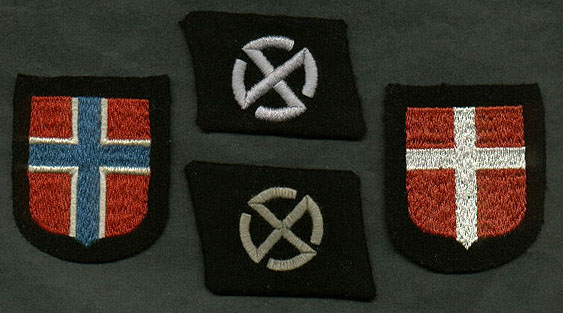
On 28 August 1943, the 11th SS Pz-Gren Nordland Division under the divisional command of SS-Brigf u Gen.
Maj. Fritz von Scholtz accompanied the rest of III (Germanische) SS-Panzerkorps on its journey to Croatia. 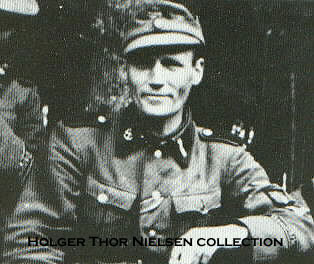
Interesting picture of Danish volunteer wearing the "Sonnrad" collar tab, Danish SS national shield and "Danmark" cuffband (pic posted with kind permission of Mr. Holger Thor Nielsen). This picture is also found in page 235 of German Military Cuffbands by Williamson and McGuirl. The Battle of European Volunteers
On 14 January 1944, the Russians began a massive offensive
on the Oranienbaum and Leningrad Fronts. By late January 1944, the division retreated towards Narva, Estonia.
During the next several months the division fought well in Narva against overwhelming odds in it what was known
as the "Battle of European Volunteers" because of all the different nationalities that participated during the
Battle of Narva. The Nordland Division fought rearguard actions at the Narva bridgehead in Estonia.
On 1 and 2 February 1944, the formations of the III. SS Panzer Corps had begun moving into the Narva bridgehead area with the forces of the 47th, 2nd Storm and 8th Soviet Armies right on their heels. The commanders of "Nordland" and "Nederland," Brigadeführers von Schulz and Wagner, were forced to reassemble their troops as quickly as possible. I. Battalion/SSRgt. "Danmark" led by Hstuf. Per Sorensen, took up positions around the main Narva-Jamburg road. To the north of I. "Danmark" were the battalions of the "Nederland" Brigade, while to the south, were more soldiers from the "Nordland" Division. Placed at the key points in the rather flimsy front, were Tiger tanks from the Army Heavy Tank Detachment 502 and 1st Company/SS Panzer Detachment "HvS "/Div. "Nordland." Along with them were the assault guns from "Nordland" and "Nederland." They absorbed the weight of the early battles for the bridgehead. During the 6 and 7 of March there were massive Soviet aerial bombardments, which cause a great destruction to the city of Narva. Below are some remarkable pictures taken by the Swedish SS-Kreigsberichter Hans-Caspar Kreuger (from the collection of Soren Nielsen): 
SS Danish volunteers riding on a German motorcycle. Notice the sidecar has the Nordland emblem and below the Danish national flag. 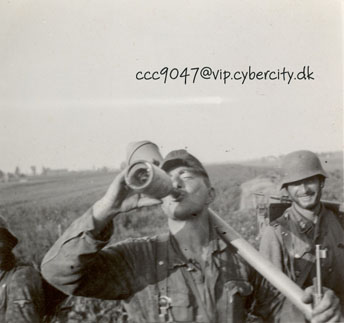
Next is a picture of Germanic volunteers enjoying a day of rest and drinking. 
The Narva bridgehead showing on your left the "Hermmansburg" Castle with the tower partially destroyed. The "Ivangorod" citadel ilustrated on your right side is completely destroyed. 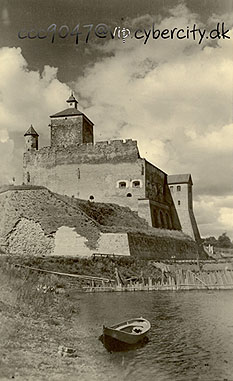
"Hermannsburg" castle shown on your right. 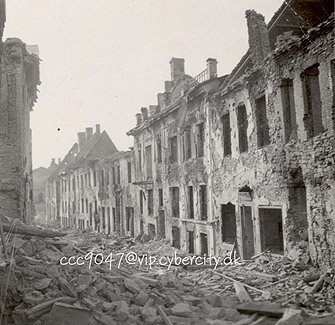
These images illustrate the destruction of the inner city. 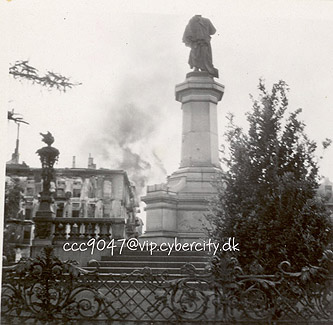
In the meantime, in early April 1944 after heavy losses, the Waffen-SS High Command decided to remove one battalion
each from the "Danmark" and "Norge" Regiments for refitting, included veteran experienced Officer's and NCO's
from the Nordland. Therefore remnants of the first battalion of "I/SS-Pz-Gren Rgt 24 Danmark" and "I/SS-Pz-Gren
Rgt 23 Norge" were withdrawn. | |
|
Nordland BeVo Cuff Band 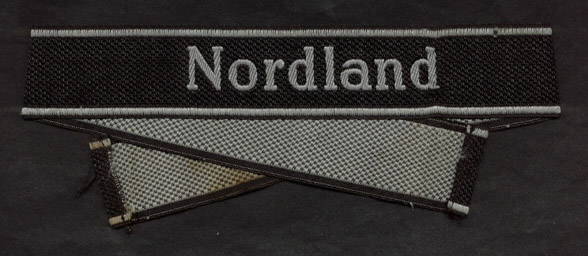
By 1943, those members of the division not entitled to wear their own unit cuffband received the machine woven "Nordland" cuffband shown above. The cuffband was made by the famous German company BeVo of Wuppertal. The trade name BeVo was an abbreviation of the word "Beteiligung" (partnership) and "Vorsteher" (name of owners). The reverse shows the recognisable "salt & pepper" design. | |
|
Retreat
By July 1944, the Nordland Division begun withdrawing from Narva to the secondary defensive lines 25kms due west of
the River Narva, known as the Tannenberg Positions. The Tannenberg defensive lines were anchored by a series of
three hills, running west to east as follows: Hill 69.9, Grenadier Hill and Orphanage Hill.
The hill referred as the Orphanage Hill was a strategic point that protected the rear side of the city of Narva.
In heavy fighting the SS "Norge" Regiment and a Panzer Group formation "Strachwitz" were able to hold against
overwhelming odds. Eventually, the battered German formations were overrun. By September 1944, the division under
the III (Germanic) SS Armored Corps had withdrawn from Estonia and started defensive positions in Latvia. There it
fought desperate battles for the defense of Riga, Latvia. By 12 October, Riga had been taken over by the Russians.
The remainder of the Nordland's service was like the rest of the German forces in Russia, a story of constant retreat.
It fought three major battles in the westerly retreat through "Kurland" (Courland). |